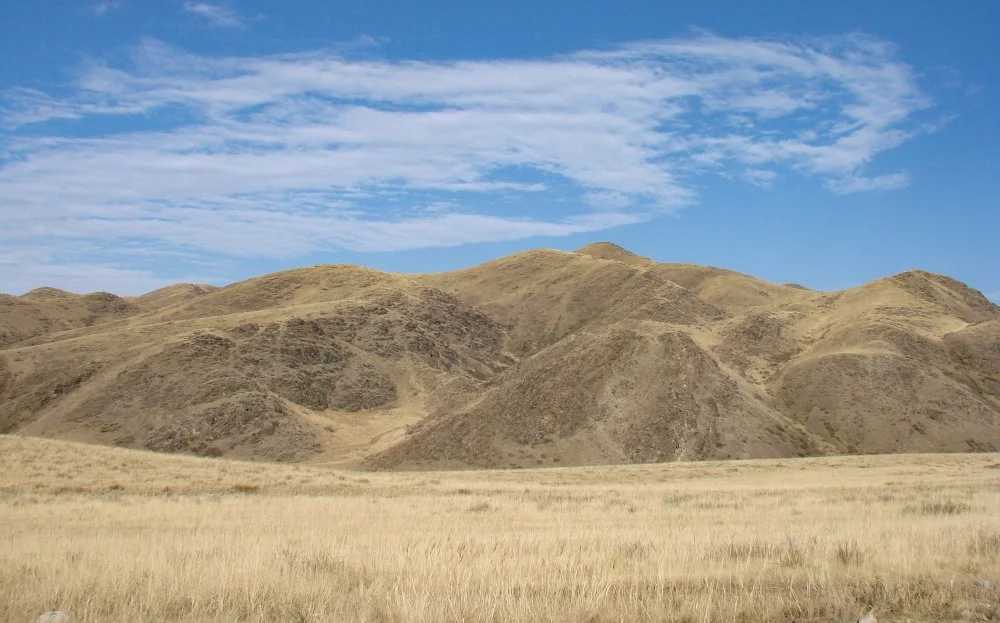In the Jetisu region of Kazakhstan, visitors specifically visit the Bayanjurek Sanctuary to see its most famous treasures: petroglyphs depicting dancing shamans.
We know that spiritually minded warriors often chose lofty mountain peaks for their rituals, which is why these figures are at the sanctuary's highest point. From there, one can enjoy an impressive view of the snow-capped peaks of the Dzungarian Alatau and the Qasqarau Valley to the south and east, as well as the vast Saka burial ground between the ridge and the town of Qapal to the west. The figures are carved on horizontal slabs facing the sky, symbolizing that the shamans perform their dances as a tribute to the sky, sun, moon, and stars, not people. These petroglyphs are a timeless whisper from our distant Bronze Age ancestors to the higher realms.

Bayanjurek views, photo/Olga Gumirova
Few people know that there are not two but three images of shamans in the sanctuary. The third was discovered in the early 2000s by an expedition led by Professor A.N. Maryashev with renowned photographer O. Belyalov. This figure can only be seen at sunset when illuminated by the angled rays of the sun.
Shamans, or figures believed to act as intermediaries between humans and spirits, are a common theme across most major petroglyph sites across Kazakhstan. Depictions of them include, for example, individuals dressed in animal skins and wielding staffs at Tanbaly Tas, a figure adorned with bull horns and a tail at Eshkiolmes, and shapeshifters wearing wolf masks at Akkainar and Kulzhabasy. Each shaman typically has a spirit guardian, or totem, from which they derive supernatural power, enabling them to journey into other realms. The shamans of Bayanjurek stand out because they look like the shamans we see in movies and documentaries—wearing feather headdresses, fringed garments, and soft fur boots. Shamans across northern Eurasia and America have performed rituals in similar attire for millennia. Judging by their designs and ritual decorations, such costumes most often represented birds, usually eagles or golden eagles. The special sacred status of these birds goes back to ancient times and is connected to their perceived proximity to the sky and the sun.

Bayanjurek shaman petroglyph , photo/Olga Gumirova
There’s still no agreement among researchers whether the varying number of feathers in the headdresses of the Bayanjurek shamans is intentional. Is it simply the artist's vision or does it hold some secret meaning that we have yet to uncover? The unusual decoration on the head of one of the figures also intrigues many. Some particularly enthusiastic individuals consider it evidence of an extraterrestrial presence on Earth. However, we must disappoint them—it is, in fact, a chariot symbol, a solar emblem. The objects in the shamans' hands are also a subject of debate. Some scholars believe they are mirrors, while others think they are drums. And both versions are plausible. Nevertheless, there is no doubt that the shamans are dancing. The figures are shown to be forward facing, with their knees softly bent, as if poised to leap, and their wide arm movements emulating the fluttering of wings. It appears as though the figures are on the verge of metamorphosing into birds and ascending to the sky.

Bayanjurek shaman petroglyph , photo/Olga Gumirova
The petroglyphs depicting shamans from Bayanjurek confirm that shamanism existed in the territory of Kazakhstan for at least 4,000 years. In ancient times, dance played a crucial role in these rituals, helping participants enter an altered state of consciousness. Shamans would visit inaccessible realms through these rituals and communicate with spirit guardians to ensure the well-being of the entire tribe.




